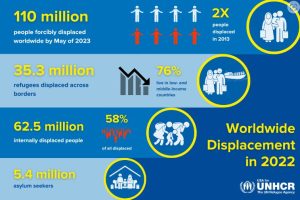Five things you should know about global displacement
The scale
Global forced displacement is at an all-time high, with the number of forcibly displaced people doubling over the past decade. Today, the global figure exceeds 110 million people forced to flee from persecution, conflict, violence and human rights violations. The represents a 21 per cent annual increase, the largest ever single year increase.
The Russian invasion of Ukraine caused the fastest and the largest forced displacement crisis since World War II — and other emergencies and climate-driven events pushed the figure over the dramatic milestone of 110 million by May of 2023.
Food scarcity, inflation and the climate crisis continue to contribute to displacement concerns.
Most refugees come from just three countries
In 2022, an estimated 52 per cent of all refugees and other people in need of international protection came from just three countries: Syria, Ukraine and Afghanistan.
The decade-long conflict in Syria has forced millions of Syrians to flee, making them the largest group of refugees with 6.5 million hosted in 131 countries. More than 75 per cent are hosted in neighbouring countries such as Turkey Lebanon and Jordan. By the end of 2022, Syrian refugees accounted for almost one in five refugees globally.
At the end of 2022, over 16 per cent or 5.7 million of the world’s refugees were Ukrainian. This was triggered by the eruption of full-scale war in Ukraine in February 2023. Almost 2.6 million refugees from Ukraine were hosted in neighbouring countries, with another 3 million in other European countries and beyond.
The total population of Afghan refugees and people in a refugee-like situation increased drastically from 2.9 million to 5.7 million by the end of 2022. This was largely due to revisions in population estimates in the neighbouring Islamic Republic of Iran in 2022, which hosts approximately nine in ten Afghan refugees.
Low and middle-income countries host most refugees
Most people who are forced to flee never cross an international border. At the end of 2022, 58 per cent of all forcibly displaced people remained in their own country. Refugees and displaced people who flee across international borders stay as close to their countries as possible.
At the end of 2022, 70 per cent of refugees, including people in refugee-like situations and other people in need of international protection, were hosted by neighbouring countries. Over the last five decades, three-quarters of these same populations remained within their region of origin.
Low-income countries continue to host a disproportionately large share of the world’s displaced population. In 2022, low- and middle-income countries hosted 76 per cent of the world’s refugees and other people in need of international protection.
Children impacted by forced displacement
Children are overrepresented in the global refugee crisis, accounting for 41 per cent of all forcibly displaced people but only making up 30 per cent of the world’s population. UNHCR estimates that more than 1.9 million children were born as refugees between 2018 and 2022 — an estimated 385,000 children per year.
Women and girls represent more than half, or 51 per cent, of all refugees forcibly displaced by the end of 2022. Compared with 2021, there were fewer children, more elderly, and more women and girls registered as refugees.
The war in Ukraine forced 5.7 million people to flee the country — refugees from Ukraine accounted for 16 per cent of the total refugee population in 2022. Refugees from Ukraine were more likely to be women and girls or elderly and less likely to be children. This is in contrast to most other countries of origin with large refugee populations.
Asylum applications soar
In 2022, the world highest number of new asylum applications ever recorded. Around 2.6 million were registered by more than 140 nationalities in 155 countries. More than two in five of the new asylum applications were made by nationals from Latin America and the Caribbean, most notably from Cuba, Nicaragua and Venezuela. Asylum applications by Afghans and Syrians also grew compared to the previous year.
The US remained the world’s largest recipient of new individual claims with 730,400 new asylum applications in 2022, nearly four times more than in 2021. The volume of new applications meant that the number of asylum-seekers awaiting a decision on their cases climbed 18 per cent to 5.4 million.
The increasing number of people forced to flee new or ongoing conflicts around the world underlines how critical the right to apply for asylum remains for millions of people worldwide.












